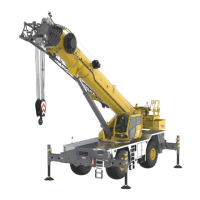Grove Published 01-29-2015, Control # 512-01 7-31
TMS700E SERVICE MANUAL POWER TRAIN
CLUTCH
Description
The clutch (Figure 7-12) is a 15-1/2 in (39.4 cm), 2-plate,
pull-type heavy duty unit. Refer to the Operator Manual for
operation instructions.
The clutch is the device that interrupts shaft power from the
engine flywheel to the transmission. When starting the
engine, the clutch is disengaged, disconnecting the
transmission and the rest of the drive train from the rotation
of the flywheel. This allows the engine flywheel to turn freely
during startup.
When the clutch is engaged, it connects the engine drive
shaft to the transmission and the rest of the drive train.
The clutch assembly has a clutch brake that stops the
rotation of the transmission gears to aid quick engagement
on engine start. It also slows down the gears on the upshift to
allow engagement of the next higher gear without gear clash.
Pressing the clutch pedal through the last one inch of pedal
travel engages the clutch brake.
Clutch pedal adjustment provides for approximately 2.5 cm
(1 in) of free travel movement of the pedal after the first free
travel of 1.3 cm (0.5 in) is passed before engaging the
release bearing fully. It is important that this free travel be
maintained to avoid possible excessive wear on the bearing
and/or clutch slippage. Approximately the last one inch of
downward clutch pedal travel engages the clutch brake
which overcomes the tendency of the clutch to rotate at high
speed when the clutch is disengaged. A slight but definite
resistance to clutch pedal downward movement will be felt at
the last one inch of travel. THE CLUTCH BRAKE MUST
NOT BE USED WHEN MAKING A DOWNSHIFT.
The clutch assembly has a cover, a pressure plate, an
intermediate plate, two driven discs, a throw-out bearing and
carrier, and springs and other linkage that allow the throw-
out bearing to press the pressure plate against the driven
discs, or pull it away.
The clutch assembly mounts inside the clutch housing of the
transmission. The clutch assembly bolts to the engine
flywheel and rotates with the flywheel. The pressure plate,
the intermediate plate, and both driven discs are inside the
clutch assembly. The pressure plate connects to the clutch
assembly with driving lugs that extend into the mating slots.
Drive pins in the engine flywheel mate with holes in the
intermediate plate to drive it.
The driven plates rotate inside the clutch assembly but are
not fastened to the clutch assembly. The driven discs’
splined center holes mate with the transmission input shaft,
but unless the flywheel pressure plate contacts them, they
will not rotate, nor will the transmission input shaft.
The throw-out bearing mounts on a sleeve that fits through
the rear of the clutch assembly. The transmission input shaft
fits through this sleeve; this allows the throw-out bearing to
be stationary while the clutch assembly rotates and allows
the throw-out bearing to move fore and aft with respect to the
clutch assembly and the transmission. The clutch release
shaft and yoke, which connect to the crank and the linkage
from the clutch pedal, connect to the throw-out bearing. This
connection keeps the throw-out bearing from turning with the
clutch and allows the yoke to move the throw-out bearing aft
and fore when the clutch pedal is stepped on or released.
Stepping on the clutch pedal causes the clutch release yoke
to pull the throw-out bearing toward the transmission. The
throw-out bearing, being connected to the release levers,
retracts the pressure plate from contact with the driven disc
assembly. This relieves the pressure on the intermediate
plate and the forward driven disc assembly, which
disengages the clutch. This stops the rotation of the flywheel
from rotating the transmission input shaft. The clutch release
yoke also holds the throw-out bearing against the clutch
brake pad of the transmission; this brakes the clutch instead
of letting it rotate on built-up energy.
Releasing the clutch pedal allows the throw-out bearing to
move toward the engine. This permits the pressure plate,
under powerful spring pressure, to move toward the
flywheel, gripping the driven discs and causing engagement.
This means the engine drive shaft output connects through
the flywheel and in the clutch’s pressure plate pressing on
the driven discs, to the transmission input shaft.
CAUTION
Never fully depress the clutch pedal before the
transmission is put in neutral. If the clutch brake is applied
with the transmission still in gear, a reverse load will be
put on the gears, making it difficult to get the transmission
out of gear. At the same time it will have the effect of trying
to stop or decelerate the vehicle with the clutch brake,
with resultant rapid wear and generation of excessive
heat, necessitating frequent replacement of the brake
friction discs.
Reference Only

